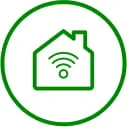In today’s interconnected world, network security has become more important than ever. With the rise of remote work, smart home devices and small home-based businesses, ensuring a safe and reliable network is essential for protecting sensitive data, maintaining productivity and safeguarding your devices from cyber threats. Whether you’re a tech-savvy homeowner, a remote worker or someone managing a small office network, optimizing your home network security should be a top priority.
The growing importance of home network security
Home networks are no longer just for casual browsing or streaming movies. They’ve become hubs for work, communication and entertainment. This increased dependency makes them attractive targets for hackers, malware and other cyber threats. Securing your network isn’t just about protecting your devices; it’s about safeguarding your personal information and intellectual property.
Common threats to home networks
- Phishing attacks: Attempts to steal sensitive information through fraudulent emails or messages that appear legitimate. These can trick users into revealing passwords, credit card details or other private data.
- Malware and ransomware: Malicious software can infect your devices, steal information or hold your data hostage until a ransom is paid. Protecting against these requires vigilance and strong security measures.
- Unauthorized access: Hackers can exploit weak passwords or outdated settings to gain entry to your network, potentially compromising all connected devices.
- Internet of Things (IoT) vulnerabilities: Smart devices like cameras, thermostats and doorbells often have limited security features, making them easy targets for cybercriminals.
Benefits of implementing proper security measures
- Protection of sensitive data: Prevent unauthorized access to personal, financial or business information stored on your devices.
- Enhanced performance: Secure networks operate more efficiently by preventing unauthorized users from hogging bandwidth.
- Peace of mind: Knowing your network is secure allows you to use it confidently without worrying about potential breaches or threats.
Router configuration and security
Basic router settings
- Changing default admin credentials: The default username and password for most routers are publicly available and easy to guess. Changing these credentials to unique, strong ones helps block unauthorized access.
- Updating router firmware: Manufacturers regularly release firmware updates to address vulnerabilities. Keeping your router’s firmware up to date ensures you have the latest security patches.
- Disabling remote management: This feature allows access to your router’s settings from outside your network, which can be exploited by attackers. Disabling it ensures only local users can manage your router.
- Setting up guest networks: A guest network provides visitors with internet access without giving them access to your main network. This isolates potential risks and protects your primary devices.
Advanced router configuration
- Implementing WPA3 encryption: WPA3 is the latest WiFi security protocol, offering stronger encryption and better protection against attacks like brute force.
- MAC address filtering: By allowing only specific device MAC addresses to connect to your network, you add another layer of access control.
- SSID broadcasting configuration: Hiding your network name (SSID) reduces its visibility to casual users or attackers scanning for networks to exploit.
- Setting up quality of service (QoS): QoS lets you prioritize network traffic for specific devices or applications, ensuring smooth performance for critical tasks like video calls or gaming.
Network optimization
Performance tuning
- Bandwidth management: Control how much bandwidth is allocated to each device or application to prevent any single user or device from monopolizing the network.
- DNS optimization: Switching to a reliable and fast DNS provider, such as Google DNS or Cloudflare, can improve browsing speed and security.
- Traffic prioritization: Assign higher priority to essential activities, like video conferencing or streaming, while deprioritizing less critical tasks.
- Network segmentation: Divide your network into segments — for instance, separate your work devices from IoT devices — to limit the impact of any potential breach.
Device security
Connected device management
- Maintain inventory of connected devices: Regularly check which devices are connected to your network. This helps you identify unauthorized devices and remove them.
- Regular security updates and patches: Ensure all devices, including smartphones, laptops and IoT devices, are running the latest software to address known vulnerabilities.
- Removing unauthorized devices: Immediately disconnect and investigate any devices you don’t recognize on your network.
- IoT device security considerations: Change default passwords, disable unused features and avoid connecting untrusted IoT devices to your main network.
Access control
- Strong password policies: Create unique, complex passwords for your network and devices, using a mix of letters, numbers and special characters.
- Two-factor authentication (2FA): Add an extra layer of security by requiring a second form of authentication, such as a code sent to your phone.
- User account management: Limit access to critical accounts and ensure each user has only the permissions they need.
- Parental controls: Use built-in parental control features to restrict access to inappropriate content and manage screen time for children.
Additional security measures
Network monitoring
- Set up intrusion detection systems: These systems monitor your network for suspicious activity and alert you to potential threats.
- Network monitoring tools: Use tools like Wireshark or Fing to analyze traffic, detect anomalies and identify vulnerabilities.
Data protection
- VPN implementation: A Virtual Private Network encrypts your internet connection, protecting your data from interception, especially on public WiFi.
- Backup strategies: Regularly back up important data to an external hard drive or cloud service to prevent loss in case of an attack.
- Encryption for sensitive data: Encrypt files and storage devices to ensure that even if data is stolen, it remains inaccessible.
- Secure file sharing practices: Use trusted platforms with encryption to share files, avoiding unsecured methods like email attachments.
Optimizing your home network security doesn’t have to be overwhelming. By taking a proactive approach and implementing the steps outlined above, you can create a secure, reliable and efficient network environment. Whether you’re working from home, running a small business or managing your family’s devices, these measures will help you stay protected in today’s digital landscape.
Ready to take the next step in securing your network? Start by reviewing your router settings and creating an action plan to address potential vulnerabilities. Your network will thank you.





